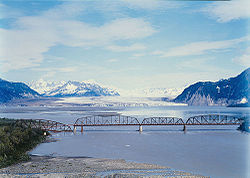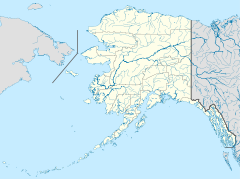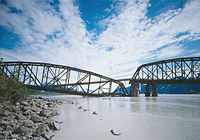- Miles Glacier Bridge
-
"Million Dollar Bridge" redirects here. For the bridge in Portland, Maine, see Million Dollar Bridge (Maine).
Miles Glacier Bridge 
Miles Glacier Bridge prior to repairs. Today far left span as seen in this photo has been lifted and put back into place.Carries road bridge[1] Crosses Copper River[1] Locale Cordova, Alaska[1] Design through Pennsylvania (Petit) truss bridge Material steel and concrete[2] Total length 1,550 feet (470 m)[2] Number of spans 4[2] Piers in water 3[2] Construction begin 1909[1] Construction end 1910[1]
Million Dollar BridgeLocation: Valdez-Cordova Census Area, Alaska Coordinates: 60°40′24″N 144°44′36″W / 60.67333°N 144.74333°WCoordinates: 60°40′24″N 144°44′36″W / 60.67333°N 144.74333°W Built: 1910 Architect: Katalla Corp.; et al. Architectural style: Other Governing body: State NRHP Reference#: 00000293
[3]Added to NRHP: March 31, 2000 The Miles Glacier Bridge, also known as the Million Dollar Bridge, was built in the early 1900s, across the Copper River fifty miles from Cordova in what is now the U.S. state of Alaska. It is a multiple-span Pennsylvania truss bridge which completed a 196-mile (315 km) railroad line for the Copper River and Northwestern Railway, built by J. P. Morgan and the Guggenheim family to haul copper from the old mining town of Kennicott, now located within the Wrangell–St. Elias National Park and Preserve, to the port of Cordova. It earned its nickname because of its $1.4 million cost, well recouped by the about $200 million worth of copper ore which was shipped as a result of its construction.
Contents
History
The Copper River and Northwestern Railway and associated bridges were built between 1906 and 1911. This bridge was the most significant of the group. However, its use as a railroad bridge ended in 1938 when the Copper River and Northwestern Railway shut down.
Work to convert the old rail bed to a road began in the 1950s, and was completed in 1958. The over-all work was halted when the bridge, and much of the highway under construction, was damaged by the 1964 Alaska earthquake. One of the bridge spans slipped off its foundation after the earthquake.
The bridge was placed on the National Register of Historic Places in 2000.[4]
Repairs
Temporary repairs, consisting of a rudimentary system of cables, I-beams, and planks, kept the bridge passable. Only about 10 miles (16 km) of four-wheel-drive road had been constructed at the other side of the bridge before the earthquake. Therefore, for two-wheel-drive motorists, the bridge is the end of the road.
The bridge was permanently repaired starting in 2004, and the repaired bridge was dedicated in August 2005. The controversial decision was made to repair it after a severe September 1995 flood caused the bridge to be impassable and also made an eventual washout of debris onto Childs Glacier inevitable. State engineers determined that it was less expensive to repair the bridge than it would be to remove it, or (in a worst-case scenario) clean up if the bridge completely collapsed into the river. Such a cleanup would have been required due to the Copper River salmon runs.
The repairs cost $16 million in federal and $3 million in state tax dollars. "I don't get it," said former Cordova Mayor Kelly Weaverling. "I hear we're going to have to cut old folks' homes and start taxing people in this state, and we're blowing millions of dollars on a bridge that's going to go nowhere. I think it's an incredible waste of money."[5]
References
- ^ a b c d e Million Dollar Bridge at Structurae
- ^ a b c d "Copper River & Northwest Railroad, Million Dollar Bridge". Washington, DC: Historic American Buildings Survey/Historic American Engineering Record, National Park Service, Department of the Interior. 1986-07-23. p. 2. http://memory.loc.gov/cgi-bin/ampage?collId=pphhdatapage&fileName=ak/ak0100/ak0192/data/hhdatapage.db&recNum=1&itemLink=r?pp/PPALL:@field(NUMBER+@(ak0192)). Retrieved 2009-06-13.
- ^ "National Register Information System". National Register of Historic Places. National Park Service. 2007-01-23. http://nrhp.focus.nps.gov/natreg/docs/All_Data.html.
- ^ "National Register of Historic Places Listings April 7, 2000". Cr.nps.gov. 2000-04-07. http://www.cr.nps.gov/nr/listings/20000407.htm. Retrieved 2011-08-28.
- ^ [1][dead link]
External links
- 1911 newspaper article about the Kenicott-Cordova line
- 1985 article from the Alaska Science Forum
- 2002 article from the Alaska Science Forum
- A panoramic image of the bridge, probably taken in the 1920s
U.S. National Register of Historic Places Topics Lists by states Alabama • Alaska • Arizona • Arkansas • California • Colorado • Connecticut • Delaware • Florida • Georgia • Hawaii • Idaho • Illinois • Indiana • Iowa • Kansas • Kentucky • Louisiana • Maine • Maryland • Massachusetts • Michigan • Minnesota • Mississippi • Missouri • Montana • Nebraska • Nevada • New Hampshire • New Jersey • New Mexico • New York • North Carolina • North Dakota • Ohio • Oklahoma • Oregon • Pennsylvania • Rhode Island • South Carolina • South Dakota • Tennessee • Texas • Utah • Vermont • Virginia • Washington • West Virginia • Wisconsin • WyomingLists by territories Lists by associated states Other  Category:National Register of Historic Places •
Category:National Register of Historic Places •  Portal:National Register of Historic PlacesCategories:
Portal:National Register of Historic PlacesCategories:- Railroad bridges in Alaska
- Bridges completed in 1911
- Truss bridges
- Bridges on the National Register of Historic Places in Alaska
- Railway bridges on the National Register of Historic Places
- Valdez–Cordova Census Area, Alaska
- Road bridges in Alaska
Wikimedia Foundation. 2010.


